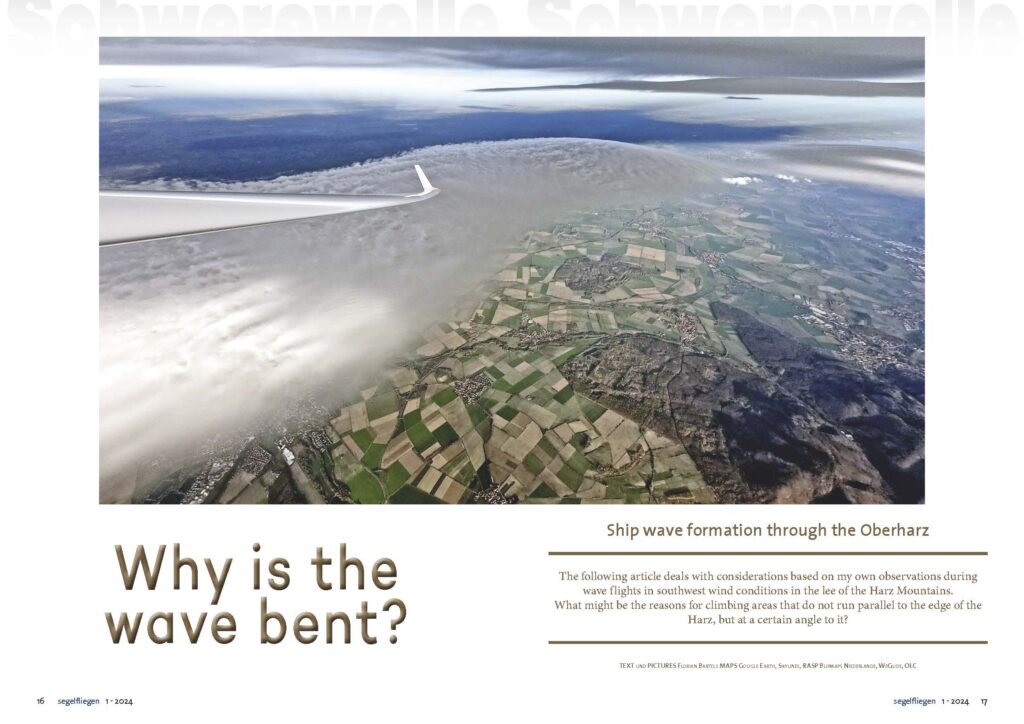Here we go with our exciting, informative and entertaining reports! We start the season in northern Italy, where numerous airfields offer top conditions for great flights in spring, show you the way from the Arlberg towards Mont Blanc in the “foehn”-wind and reveal a few secrets for perfect slope flying at Porta Westfalica. There we take a look at the lee of the Harz mountains, where waves sometimes are bent and there are climbing areas where you wouldn’t expect them. another surprise is Regtherm: the thermal forecast model will be discontinued by the DWD at the end of March and continued by XC-Therm with 1000 new forecast regions all over Europe. Then we introduce you to ASASys (anti-stall assistance system): The idea is a system that not only warns the pilot better of a stall, but can then also intervene to give the pilot a few seconds to end a potentially dangerous flight condition. Some other pilots see their hobby in danger simply because of their age, but how old is too old? A report by the British Gliding Association answers this question. Another question, whether assembly aids are helpful or risky, is answered by our deputy editor-in-chief. To ensure that everything runs smoothly, here are 13 steps for rigging and de-rigging. It should then also remain relaxed in the air, a sticking point here can be the correct and safe power supply. We show you how to do this using a two-seater. In short, there are a few tips on buying used trailers before we look back 100 years to the „discovery“ of thermals. And finally (or perhaps first?), our column invites you to smile and dream a little about the most beautiful hobby in the world. We hope you enjoy reading it! Order here.
And here’s a look at the current magazine:

The following article deals with considerations based on my own observations during wave flights in south-westerly wind conditions in the lee of the Harz Mountains. What might be the reasons for wave crests that do not run parallel to the edge of the Harz, but at a certain angle to it?
My observations of wave soaring in the Harz over the last few years show what the title and the lee waves in the Harz are all about. Since the early 2000s, I have been taking off from the „Große Wiese“ gliding site on the southern edge of Wolfenbüttel in south-westerly winds in the direction of the northern edge of the Harz in order to enter the waves there.(…)
The shortest route from Wolfenbüttel to the edge of the Harz Mountains near Bad Harzburg is 26 km, the shortest route to the most reliable entry point in Brockenlee is approx. 33 km. In take-off direction 25, the flight path generally leads east of the Oderwald forest towards the south. Here, from the southern end of the Oderwald, it is important to keep an eye on the vario and any clouds, as sometimes usable secondary to tertiary waves form in this area between the Harly mountain range and the direction from Osterwieck to Halberstadt. I always make it my goal to use these waves in gliding and to fly from there to the primary wave at the edge of the Harz.
During a flight on 12.10.2019 with cumulus clouds, I managed to enter the wave at an altitude of approx. 1000 m south of Hornburg after first flying under and then, by flying upwind of the cloud, into a laminar flow on the windward side, which took me above the condensation level. Strangely, the cumulus cloud edges lined up from there did not run parallel to the resin edge (110°/290° orientation), but at an angle of approx. 30° (140°/320°) to it in the direction of Brockenlee. I was thus able to work my way there while maintaining altitude along the cloud lines. On subsequent flights I deliberately tried to repeat this flight path even when there were no cloud indications, which I sometimes succeeded in doing in sections.
If you look at these supporting lines on the chart of the logger, the area deviating from the edge of the resin at a certain angle is clearly noticeable.
But how can this „anomaly“, the deviation from the classic wave updrafts running more or less along the resin edge, come about? I remembered satellite images of islands under cloud cover in the sea, behind which more or less V-shaped cloud formations also form. These wave structures are known as ship waves. The diffraction of the waves changes from a rectilinear V to arc shapes.
The whole article can be found in the current issue of soaring international

